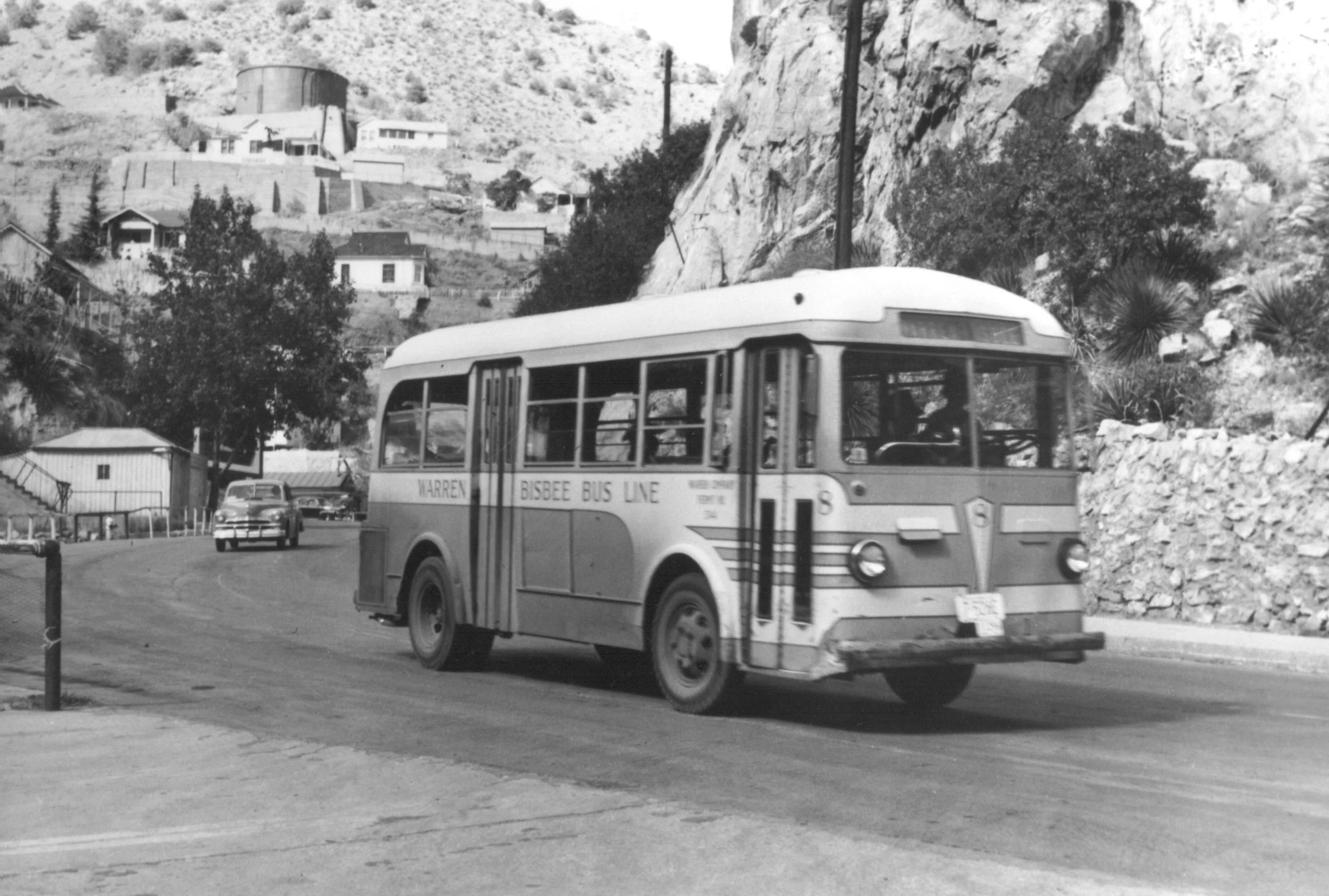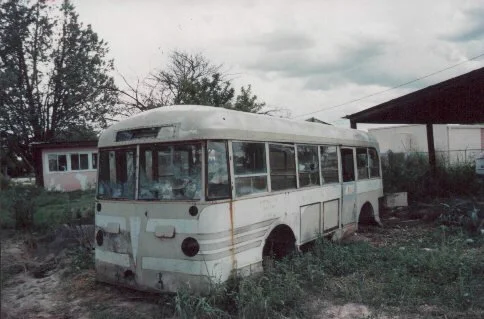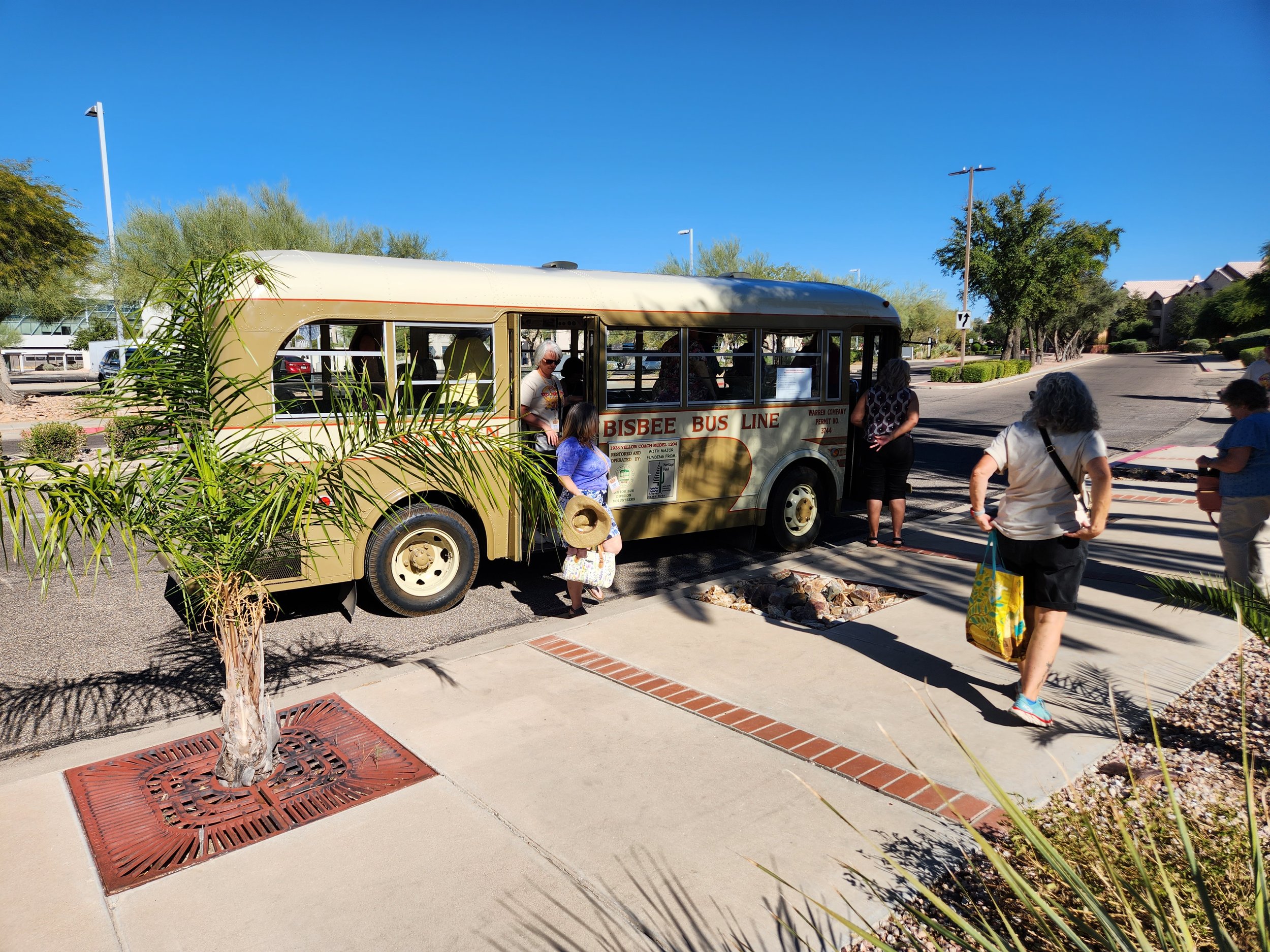Warren-Bisbee Bus Line #8
#8 winding up Tombstone Canyon in Bisbee, AZ, 1951
Background
The late 1920s through the 1930s was a time of great transition in the development of transit buses. Originally all buses were built on a truck chassis in the conventional style with an engine out front. As purpose built buses began to appear, manufacturers experimented with the placement of the engine, trying both mid-bus and engine-forward with the body built over the engine. Both provided more inside room, but the engine next to the driver was too hot and noisy to endure all day long, especially during summer months. Thus, once an angle drive was perfected, the engines typically were moved to the rear where they have stayed in most transit buses ever since. In 1938, Yellow Coach (owned by General Motors) introduced the Model 1204, a 24-passenger, front-engine bus based on a previous front-engine design.
Warren Bisbee Railway #102 proceeds down Main Street
Service History
On June 1, 1928, the company name was changed to the Warren Bisbee Bus Line when two 40-passenger Twin Coaches (#1-2) and four 21-passenger Studebaker buses (#3-6) were substituted for the streetcars. Ten years later the Studebakers were replaced by two 24-passenger model 1204 Yellow Coaches (#7-8).
Drivers pose in front of a Yellow Coach in their forest green uniforms
They served through World War II. Their aluminum bodies made them light-weight, thus fuel efficient, while their standard Chevrolet 216 engines made them very reliable. They stood up well throughout the stress of dramatically increased ridership during the war.
WBBL #8 as it was found in St. David, AZ in 1995
WBBL #8 post-restoration
Post-Service History
In 1951, the Twin Coaches and the Yellow Coaches were retired and replaced by Ford Transit buses. That year, the Warren-Bisbee Bus Line sold at least one Twin Coach and one Yellow Coach to the Southern Arizona Auto Company of Lowell. They were in turn sold to Orrin and Edna Soles of Warren who drove them to property they owned near the intersection of Double Adobe Road and Frontier Road about 10 miles east of Warren. They had a well drilled and power brought to the property and started to convert the buses to a rural retreat. Unfortunately, vandals began to damage the buses and they soon gave up the project, leaving the buses to further vandalism and decay from the weather.
In July 1995 OPT contacted the Soles about donating both buses. The Yellow Coach, which was Warren-Bisbee Bus Line #7, was moved to Tucson on August 19, followed by the Twin Coach on September 9.
On the return from a trip to Bisbee on July 1, 1995 to survey whether the two buses were worth saving, and what would need to be done to move them, OPT discovered the body of a second Warren-Bisbee Bus Line Yellow Coach (# 8) in nearby St. David. Its body was in good shape compared to #7. However, #7 still had many of the running parts and even some interior parts missing from #8. Thus a decision was quickly reached to restore #8 (if it could be obtained) using parts from #7.
Inquiry at the nearest house led to the owners, Jack and Flora McRae, who agreed to donate the bus. The McRae family had purchased the bus it when it was retired, and converted it to a road side food concession stand. When that use ended, it was kept for storage. The axles had been removed to make a small trailer, which they no longer had a use for and donated along with the bus. On September 9, 1995, #8 was moved to Tucson.
Despite years of neglect, the body of #8 was surprisingly intact. Most of the window glass and both doors remained extant which protected it from the weather. While the body of #7 had been badly vandalized, it still had the motor, transmission and air compressor, along with both axles, drivetrain, as well as a number of interior parts, including steering wheel, instrument panel, remains of one seat, and most of the handrails. All of these factors made restoration of #8 possible.
Model 1204 Yellow Coaches are extremely rare. Out of the 770 built between 1938 and 1941 only one other is known to survive.
Progress was slow, but restoration was completed in 2007. It remains one of OPT’s jewels in the collection, although it is currently on light duty to address fuel tank issues.
Restoration Status
#8 is fully restored and mechanically sound.
Ownership Snapshot
Original Owner: Warren-Bisbee Bus Line #8
Acquired From: Jack and Flora McRae in 1995
Current Livery: Warren-Bisbee Bus Line #8
Technical Specs
Year Built: 1938
Manufacturer: Yellow Coach (GM)
Model: 1204
Serial: 234
Powertrain: Chevrolet 216 inline 6-cylinder 85hp gas engine with a 3-speed manual transmission
Body: Aluminum
Length: 23 ft 6 1/2 in
Width: 83 in
Seating: 24 passengers, transit seats, with two-and-one seating










